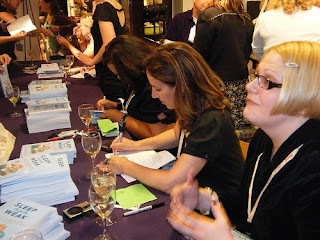 On Saturday, I posted about the New York Times and their coverage that same evening of the BlogHer 08 Conference in their online Fashion & Style section (The Sunday Styles section in the print version). I was particularly upset about where the paper placed the story and the overall tone of the article. I also wrote a brief letter to the editor that day that expressed my thoughts on the topic. You can read my post and my letter to the editor right here.
On Saturday, I posted about the New York Times and their coverage that same evening of the BlogHer 08 Conference in their online Fashion & Style section (The Sunday Styles section in the print version). I was particularly upset about where the paper placed the story and the overall tone of the article. I also wrote a brief letter to the editor that day that expressed my thoughts on the topic. You can read my post and my letter to the editor right here.Yesterday, I got a phone call and an email from a New York Times editor in response to my letter, asking simply if I would please call her. So I did, about an hour later.
The contact is an editor for the Thursday and Sunday editions of the Times’ Styles section (known as the Fashion & Style section on the online version). She said she was contacting me because she wanted me to consider revising the letter I had written to the editor because they couldn’t publish it as it was. (She also mentioned that she had read my post and several others expressing similar criticism for the story and its placement).
So, naturally, I asked why. She said that my letter specifically criticized the placement of the story, which it did. But she went on to explain that the Times’ sections operate somewhat autonomously, and when one section gets a good story, they would never “give it away” to another section. She said that the section in which a story was placed was not something they “controlled”, but that it was based on which section editor got the story or whom the reporter chose to pitch.
Effectively, she told me that they wouldn’t publish my letter if it talked about the placement of the story since the section placement wasn’t “something [they] could respond to” and was something they “don’t have an answer for”. Instead, she suggested that if I framed my letter to focus instead on tone and content of the story itself, I could resubmit it to her directly for publication consideration.
What?
There’s a couple of big lessons to be learned here about proper outreach to your community, and how not to engage with bloggers.
Mistake #1
First of all, a letter to the editor is intended as an expression of opinion by the readership of a paper. A publication could reasonably edit a letter for length, but suggesting that content and intent of a letter be revised and resubmitted for the purposes of making it easier or more palatable to the paper isn’t reasonable (or ethical, in my view).
In this case, the Times didn’t want to publish my criticism of the editorial judgment because they would have then had to explain how and why stories get placed in specific sections. They also might have had to defend the content of their Style section and justify why it was a suitable place for the BlogHer story after all. So they’ve made my letter to the editor about what it does (or doesn’t do) for them, instead of about engaging and including the voice of their readers.
Lesson: When engage in dialogue with your community, you lose credibility and respect when you try to censor or influence that conversation just because you don’t like what’s being said.
Mistake #2
In our follow up correspondence after the phone call, the editor asked that, should I choose to blog again on this topic, I not reveal her name because she’s “not a higher-up in the section” and would “rather not be seen as speaking on behalf of the section in print.” However, her phone call to me was from her desk at the Times, and her email to me was from her New York Times email account. In both cases, she was clearly presenting herself as a representative of the paper whose duties, per her email to me, “include [responding] to letter writers.”
They say in journalism that nothing is ever truly off the record. The Times, however, via this editor, is asking to be exactly that.
Lesson: If you’re going to be a part of the conversation, be transparent. Own your viewpoint and speak as yourself. Otherwise, your community questions your motives and you lose their trust.
So what should they have done?
Here’s my take:
• Either chosen to publish my letter as it was, or chosen not to publish it as is their prerogative (after all, publication isn’t guaranteed). But never should their response have been to try and convince me to amend my opinion because they didn’t have a suitable response.
• Commented on my post. The editor mentioned that she’d read my blog post about it, and that gave her and the Times the perfect opportunity to engage in the conversation and contribute their perspective.
• Respected my stance rather than trying to influence it. They didn’t have to agree with me. But trying to get me to revise my letter to the editor or suggest how I should treat future blog posts tells me that they’d rather control the message than have a discussion.
Let me be clear that I think the Times, in theory, made the right move by reaching out to someone who is clearly speaking up about them, and to them. Engagement is much better than ignoring. But the question becomes what does more damage: Not responding at all, or responding and trying to influence a letter writer or blogger to amend their content?
I think the piece itself and the editor’s response to my letter underscores the lack of respect that the Times has for bloggers, their readers, and their influence within the larger media community. The overall tone of the exchange with the editor, while courteous and friendly on the surface, leads me to think that the Times not only wants to unduly influence the conversation, but that they might be taking this ill-advised approach with other bloggers, too.
This whole situation highlights an archaic and potentially damaging system that papers like the Times are using to determine where their stories run. I think they ought to be rethinking this for the sake of integrity.
So what do you think? How would you have reacted to such a request? Do you think the New York Times handled this correctly? If not, what should they have done differently and what are the lessons to be learned?
Photo by Anderson Mancini






















